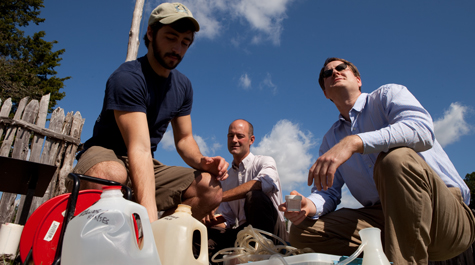National Geographic Society joins Starving Time water study
The National Geographic Society has become involved in an investigation of possible contaminants in the water that the original Jamestown colonists drank in the early 17th century.
A collaboration of geologists and historians at William & Mary are investigating the role that the water might have played during the Starving Time. For the past couple of years, a team of William & Mary geologists led by Jim Kaste and Greg Hancock has been sampling water from the same wells inside the Jamestown fort used by the colonists. They’ve found that the shallow aquifer of Jamestown Island has water that was barely drinkable at the best of times and at the worst of times, perhaps even toxic.
The investigation is covering the first 20 years following the 1607 founding of the Jamestown colony, which includes the dark period of 1609-1610 in which the colony almost died out—literally.
The Starving Time began with the breakdown of relations among Powhatan Indians and the colonists following John Smith’s return to England. The geologists hypothesize that their drinking water supply, which included water from the river and from wells in Jamestown Fort, was mainly responsible for the ill health that characterized the Starving Time. William & Mary historians Jim Whittenburg and Julie Richter are probing Colonial-era death records to test the hypothesis.
A grant from National Geographic is supporting the collaboration’s work on the historical mystery, which was named one of the ten top historical stories of 2011 by History.com. Key to the water-toxicity hypothesis is the seasonality of the deaths of Jamestown colonists.
“There’s evidence that things were worse in Jamestown than they were in other settlements nearby. There was something about Jamestown that caused very high death rates,” Kaste said. The William & Mary group believe that “something” was something seasonally toxic about the water.
Kaste explained that the aquifer under the Jamestown fort is vulnerable to infiltration from two sources of pollutants, the James River and Jamestown Island’s own Pitch and Tar Swamp. Readings from a National Oceanic and Atmospheric Administration buoy off Jamestown Island show that the James River varies widely in salinity, depending on tide, rainfall and other factors.
“The water fluctuates from very fresh to quite salty,” Kaste said. The salinity ranges from .5 parts per thousand to nearly 12 parts per thousand. The James doesn’t get as salty as the open ocean, with salinity at about 35 parts per thousand, but at times the river water gets too salty to drink.
The geologists have determined that the James River at Jamestown is at its saltiest in summer, when salinity climbs to a level of about a third of sea water.
“If you were out on a raft and had to drink that water, you wouldn’t last too long,” Kaste said.
As the water in river gets saltier, so does water in the aquifer. The sandy geology of Jamestown Island means that infiltration of salt from the James into the aquifer happens quickly: Hancock said that the wells registered the temporary saline influx generated by the storm surge of Hurricane Sandy.
Whittenburg notes that the Starving Time records from the Jamestown colony show a spike in deaths that looks like it corresponds to the seasonal spike in water salinity.
Whittenburg and Richter are poring over records of Virginia’s Colonial era, up to around 1630. They want to see if the summer death spike is unique to Jamestown. It’s a challenging bit of research, even for veteran scholars associated with the NIAHD—the National Institute of American History and Democracy, a partnership between William & Mary and Colonial Williamsburg.
“We’ve discovered that the least likely thing to be recorded about the deaths of these people is the month in which they died,” Whittenburg said. Most of the records he’s examined list the deceased according to a “dead by” date, a common practice to accommodate legal requirements.
He said as the historians go forward in their record search, they’ll try to extrapolate from the “dead by” dates. Richter is attempting to add context to the death records by combing texts relating to early Jamestown for any first-hand observations of death, disease and the water supply.
 Skip to main content
Skip to main content

